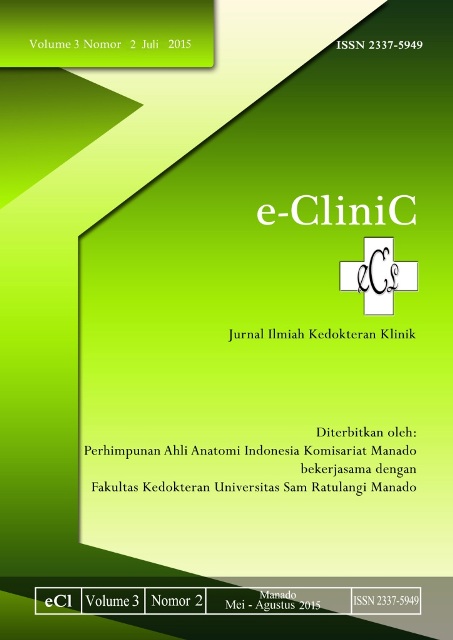PROFIL MOLA HIDATIDOSA DI BLU RSUP PROF. DR. R. D. KANDOU MANADO
DOI:
https://doi.org/10.35790/ecl.v3i2.8601Abstract
Abstract: Mola Hydatidosa is one of the trophoblast gestasional disease. This disease occured in 1 out of 40 labors in Indonesia. This study aimed to obtain the profile of mola hydatidosa in Prof. Dr. R. D. Kandou Hospital Manado. This was a descriptive retrospective study using the medical records of cases in Obstetric Gynecology Department Prof. Dr. R. D. Kandou Hospital Manado 1 January 2012 – 31 December 2013. The results showed that there were 39 cases of mola hydatidosa during that period. The most frequent cases were 20-29 years old (43.6%), the third parity (30,8%), senior high school (59%), hemoglobin level <10 g/dL (53,8%), and treated with curettage procedure (66.7%).
Keyword: mola hydatidosa
Abstrak: Mola hidatidosa merupakan salah satu penyakit trofoblas gestasional. Data di Rumah Sakit di Indonesia menunjukkan 1 kasus mola hidatidosa per 40 persalinan. Penelitian ini bertujuan untuk mengetahui profil mola hidatidosa di BLU RSUP Prof. Dr. R. D. Kandou Manado. Penelitian ini bersifat deskriptif retrospektif dengan menggunakan catatan rekam medik dengan subjek penelitian ialah semua kasus di Bagian Obstetri Ginekologi BLU RSUP Prof. Dr. R. D. Kandou Manado periode 1 Desember 2012 - 31 Desember 2013. Hasil penelitian memperlihatkan 39 kasus mola hidatidosa dengan distribusi terbanyak menurut kelompok umur 20-29 tahun (43,6%), paritas 3 (30,8%), pendidikan terakhir pada tingkat SMA (59,0%), kadar hemoglobin <10 g/dL (53,8%), dan penanganan terbanyak ialah kuretase (66,7%).
Kata kunci: mola hidatidosa
Downloads
How to Cite
Issue
Section
License
COPYRIGHT
Authors who publish with this journal agree to the following terms:
Authors hold their copyright and grant this journal the privilege of first publication, with the work simultaneously licensed under a Creative Commons Attribution License that permits others to impart the work with an acknowledgment of the work's origin and initial publication by this journal.
Authors can enter into separate or additional contractual arrangements for the non-exclusive distribution of the journal's published version of the work (for example, post it to an institutional repository or publish it in a book), with an acknowledgment of its underlying publication in this journal.
Authors are permitted and encouraged to post their work online (for example, in institutional repositories or on their website) as it can lead to productive exchanges, as well as earlier and greater citation of the published work (See The Effect of Open Access).







